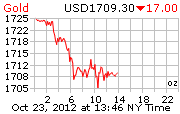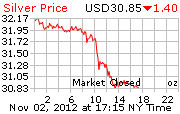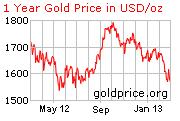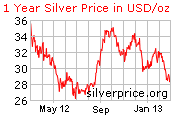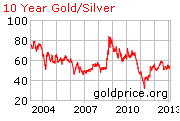Ted Butler: Silver Shocker
March 07, 2011 | By: Theodore Butler | SilverSeek | Highlight by PMbug
Silver Shocker
Here’s an extended excerpt from the Weekly Review sent to subscribers on March 5, 2011
The big surprise was in the silver COT, where the big 4 increased their net short position by 3000 contracts on the previously mentioned reduction of 1300 contracts in the total commercial net short position. This increase in the big four’s short position broke the pattern of a reduction in the concentrated short silver position that had been in force for months. The increase in the concentrated short silver position was so unexpected by me that I thought, at first, it must have been a mistake. Since the Bank Participation Report was released late yesterday, an hour or two after the COT, my first thought in the interim was that it would not be JPMorgan increasing its concentrated short position, but most likely the other three entities in the big four. After all, with all the negative attention (and losses) accruing to JPMorgan and its big silver short position, there would be no way JPM would have accounted for the 3000 contract increase in the COT for the big four.
If the silver COT was a surprise, then the Bank Participation Report was a shocker. There was a net increase in the US bank category of 6000 contracts to 25,000 held net short in silver. JPMorgan’s net silver short position, which had decreased by 11,000 contracts over the preceding three months to 19,000, had suddenly ballooned to 25,000 contracts (125 million ounces). From my reading of both these reports, it appears that the big increase in silver short selling by JPM took place during the last COT reporting week, even for the BP Report. Before I continue, let me explain that I consider JPMorgan to effectively account for all or the bulk of the entire US bank category in the Bank Participation Report for a variety of mathematical reasons. However, it matters little if there is another US bank also holding a significant net short position in COMEX silver, as all that would mean is that two US banks are colluding to manipulate the price of silver and not just one bank acting alone.
Two and a half years ago, I had a very similar experience of shock over a Bank Participation Report. This was before anyone knew that the Bank Participation Report even existed. The August 2008 Report caused me to write a series of articles that started with “The Smoking Gun” in the fall of that year. In turn, my analysis and writing led to the current CFTC silver investigation (still unresolved) and the revelation that JPMorgan was the big COMEX silver short by way of taking over Bear Stearns. I further believe that the revelation of the true size and nature of the concentrated silver short position has contributed to the current movement towards position limits by the CFTC.
As much as the August 2008 Bank Participation Report was shocking, the current one is even more so. That’s because we know so much more today than we did back then. We have waited two and half years to hear anyone legitimately explain how a US bank holding a short position equal to 25% of world production isn’t manipulation. No explanation has been forthcoming, nor is it likely to ever be offered. We know now that concentration is the prime requisite for manipulation. To witness the most concentrated participant suddenly increase its silver short position by more than 30% is something almost beyond comprehension.
Let me walk you through the mechanics of what just took place and then I’ll speculate on the motivation of JPMorgan increasing its silver short position so dramatically. Over the past two COT reporting weeks, it has been primarily a commercial versus commercial type affair. The big technical funds have largely refrained from adding to their net long silver position, even though prices have climbed very sharply. Two weeks ago the raptors (the smaller commercials away from the big eight) increased their net short position to 4000 contracts, the highest level in four years. The raptors were selling to the smaller unreported category traders who were buying. This week, the raptors bolted from their entire short position, buying it back completely and leaving them flat (not net long or short). JPMorgan was the sole seller to the raptors’ buying, resulting in the big increase in JPM’s short position.
As far as the motivations behind this trading, the most plausible explanation for the raptors running from their newly initiated big short position is the stark reality that shorting silver has been a very bad deal. My guess is that the raptors did their homework on silver only after they put on the big short and started to lose money on rising prices. That homework persuaded them to get off the short side of silver pronto, which they did. JPMorgan’s motivation for suddenly and greatly increasing its silver short position is less clear and more troubling. My own guess is that the JPMorgan silver trader thought he had no choice but to sell many more contracts short in order to control the price and protect their existing short position. That’s because there was no one else left to sell. If JPMorgan didn’t sell, no one else would have (at prevailing prices). That’s the problem and it goes to the heart of the crime. The raptors didn’t want to sell, nor did the 5 thru 8 large traders. Ditto for basically all the other silver traders. That left JPMorgan as the sole silver seller, as the COT and Bank Participation Reports clearly document. Please think about this.
We know that concentration in any market is to be avoided. The whole thrust of commodity law goes towards preventing concentration. We know that the ideal profile of a free market is where a wide diversity of market participants competes on both the buy and sell sides of the market. We also know that the most extreme state of concentration possible is where there is, effectively, only one buyer or one seller. Therefore, what the latest COT and Bank Participation Reports just confirmed was that the most extreme form of concentration possible just occurred during the latest reporting week.
This is the key point – what would have happened if JPMorgan hadn’t sold short the additional 6,000 silver contracts (30 million oz) when they did? Asked differently, in the current market conditions, what price would have been required to induce other market participants to sell the 6,000 contracts if JPMorgan hadn’t sold? My guess is that would have taken a price over $40 or $50 to attract that much legitimate selling. The fact that JPMorgan was the sole seller is the clearest proof possible that silver has been manipulated.
So egregious was this latest increase in JPMorgan’s short position that I am inclined to think that it may have been done on an unauthorized or rogue trader basis. Perhaps JPM management and the CFTC are not yet aware of it, seeing how recently it occurred. After all, the COT and Bank Participation Reports were only published less than 24 hours ago. (As is my custom, I will be sending this article to the Commission and JPMorgan and the CME Group).
I realize that I am making serious allegations of violations of commodity law, as there is no market crime more serious than manipulation. At the very least, this new government data release is so disturbing that it should be addressed immediately. Silence on the part of JPMorgan, the exchange and the CFTC is no longer constructive. If my accusations are off-base, then I should be set straight. I’m not out to cause trouble; I am trying to help correct what I see as a very serious market problem.
I can’t help but think that Chairman Gensler of the CFTC will be troubled by this recent action by JPMorgan to substantially increase its already concentrated silver short position. In recent speeches he has indicated his support for position limits to guard against concentration. Please scroll down to the section on position limits in this recent speech to see what I mean. Chairman Gensler also solicits your public comments on this issue, as I have done previously. I found it interesting that he singled out position limits in this speech for encouraging you to comment. By the way, the number of public comments on position limits is now close to 3,000, a truly remarkable outpouring of public sentiment.
Please don’t assume that the sharp increase in short selling by JPMorgan is automatically bearish for the price of silver. Yes, such manipulative short selling in the past has led to sharp sell-offs and could again. But things do change and current conditions in silver are vastly different than they have been in the past. While we must be prepared for a sell-off (by not holding on margin), this situation could (and should) blow up in JPM’s face. They are increasingly isolated which makes them both dangerous and vulnerable. Most of you are holding silver from prices much below the current levels. This bestows on you a power that few newcomers to silver possess, namely, the power of a long term perspective and the ability to withstand short term price gyrations. You have a price cushion and the power of knowledge that should enable you to persevere against any short term manipulation. The proper approach is to hold silver to go much higher and not to lose your position, just as it has been all along.
That aside, you should be disturbed enough about the revelations in the new COT and Bank Participation Reports to rattle on the cages of JPM, the CME and the CFTC. Just as a head’s up, I may make portions of this report available in the public domain if I conclude it will benefit subscribers. Let me think about it a bit. In the interim, please contact these parties if you feel so inclined. You know I will.
Ted Butler
-
October 20, 2011 at 2:33 AM | #1Gold, Silver, Gold Prices, Silver Prices, Gold News, Silver News




